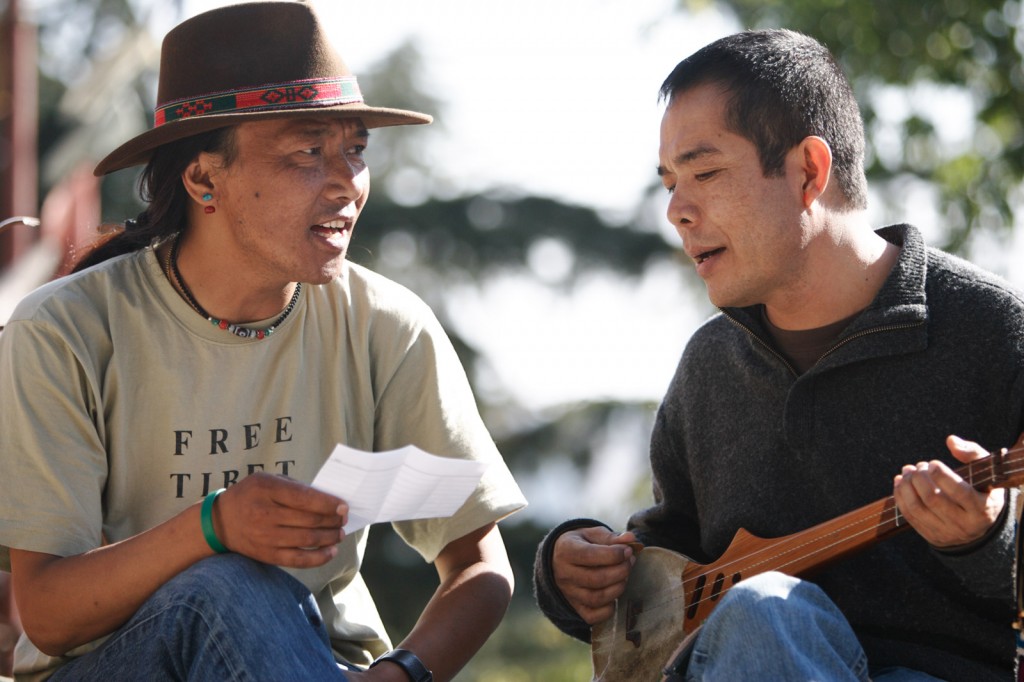Mon 4 Oct 2010
Songs in the Key of Tibet
Posted by Ethan under Film Review, NYC Film Critic
Comments Off on Songs in the Key of Tibet
Tibet in Song
Directed by Ngawang Choephel
***
The new documentary Tibet in Song begins as a personal travelogue in which director and Tibetan-born musicologist Ngawang Choephel journeys to the country he left as a child in 1968. At that time, he and his mother fled Tibet in order to escape the damage wrought by the Cultural Revolution in China, which had seized control of its neighbor a decade earlier. In 1995, the now-grown Choephel returns armed with a video camera and a notebook to record examples of the indigenous folk music he heard in his youth and continued to listen to while in exile.
Once a vibrant part of day-to-day life in Tibet, folk music had steadily vanished from view under Chinese rule, replaced first by patriotic anthems and later by the powerhouse Mandarin pop industry. While touring the country’s capital Lhasa and several surrounding small towns, Choephel is surprised—and more than a little dismayed—by the sheer number of nightclubs and karaoke bars where native Tibetans dance and sing along to pop hits rather than the stirring folk songs he grew up with.
Of course, every previous generation complains about the insipidity of the popular music of the present day, but as Tibet in Song argues, the disappearance of folk music from the public sphere was part of a larger campaign spearheaded by the Chinese government to cut the country’s population off from their history and culture. In some cases, familiar folk tunes were re-written as paeans to Mao Zedong (which were then sung by state-approved Tibetan singers) and supposedly traditional folk performances adopted Communist themes and imagery. Tibetans that did attempt to publicly perform folk songs in their original form were often subjected to harassment and even imprisonment. Choephel witnesses the success of these tactics firsthand when he asks a young Tibetan boy to sing for the camera and the first tune that pops into the child’s head is an ode to the Chinese military that he was taught in school. Fortunately for his film, the director is able to find and film several singers that continue to perform traditional folk songs, although most of them live well outside urban areas and don’t often perform for large audiences.
Already a prominent presence in the film, Choephel becomes its central focus in the second half when he’s detained by Chinese authorities while en route to visit the childhood village he had left almost three decades before and where his father still lives. Arrested on the charge of filming “sensitive material,†he was given an 18-year prison sentence and locked away in a series of dilapidated prisons. He continued to pursue his work, writing down folk songs sung by his fellow inmates on cigarette cartons. (After those cartons were discovered and destroyed by prison guards, he dedicated himself to memorizing every new song he heard.) Meanwhile, his mother toured the world speaking out on his behalf, gaining the attention of several prominent advocacy groups, politicians and musicians (including an ex-Beatle, Paul McCartney). In 2002, six-and-a-half years after his arrest, Choephel is freed and moves to the U.S., where he currently resides.
Overall, Tibet in Song provides an impassioned, yet relatively clear-eyed account of its director’s turbulent homecoming. The finished film consists of scenes film by Choephel on his initial 1995 trip (he sent half of his material out of the country before he was arrested) as well as more recent footage shot by other camera crews (operating under the director’s guidance though, for obvious reasons, not his presence). While the movie argues strongly against China’s presence in the country, it avoids turning into a litany of restrictions and abuses that may have been inflected on the Tibetan people. Even the circumstances of Choephel’s imprisonment are relayed in a straightforward manner—he mentions the harsh conditions, but doesn’t wallow in the details to trigger our pity. He’s more concerned with making sure audiences understand that there is a dedicated movement within Tibet to maintain such centuries-old traditions as folk music. At the same time, their numbers are shrinking, not simply due to the opposition they encounter from China, but also the advancements (and distractions) of modern life. As the director points out early in the film, Tibet remained an isolated nation well into the 20th century and its only within the past few decades that people have enjoyed ready access to such technologies as recorded music and television. The question the movie can’t answer is: even if China was removed the equation today, would folk music still seem as relevant to the new generation of Tibetans as it was to their ancestors? It’s vital to the health of a nation that its citizens be able to enjoy free and open access to their history and culture, but at some point, old traditions will still fall by the wayside to make room for the new.
Tibet in Song is currently playing in limited release in New York and will open in additional markets—including Portland, Boulder and Chicago—over the next two months.  Visit the film’s official website to learn more.




No Responses to “ Songs in the Key of Tibet ”
Sorry, comments for this entry are closed at this time.